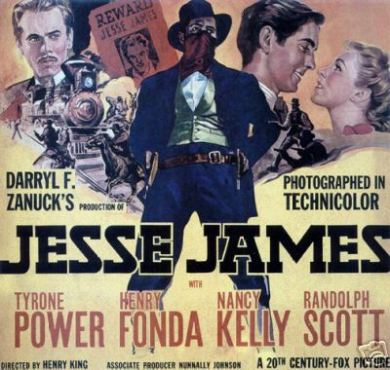The ordinary farmer boys Jesse and Frank James turn into the country’s most notorious outlaws when ruthless railroad agents try to take away their property.
Based on real life characters, the James brothers became one of Hollywood’s idealized and glorified symbols for righteous people that were forced to get on the wrong side of the law.
Jesse James was directed by Henry King (“David and Batsheba”, “The Snows of Kilimanjaro”, “Love Is a Many-Splendored Thing” a.o.). A very handsome Tyrone Power can be seen in the role of the main character. He is supported by legendary character actor Henry Fonda as the older brother Frank, western star Randolph Scott as Marshall Will Wright, and horror legend John Carradine as Bob Ford. Over the years this story was adapted many times for the big screen, and although recent portrayals have become more and more realistic, from this film on it stayed to be a Hollywood tradition to use some of their coolest and best looking guys for this part:
Roy Rogers (“Jesse James at Bay”, 1941), Audie Murphy (who actually played Jesse twice in “Kansas Riders”, 1950, and “A Time For Dying”, 1969!), Robert Wagner (“The True Story of Jesse James”, 1957), Ray Stricklyn (“Young Jesse James”, 1960), James Keach (“The Long Riders“, 1980), Kris Kristofferson (“The Last Days of Frank and Jesse James”, 1986), Rob Lowe (“Frank and Jesse”, 1994), Colin Farrell (“American Outlaws“, 2001), and eventually Brad Pitt (“The Assassination of Jesse James by the Coward Robert Ford“, 2007).
However, despite these idealizations of the American outlaw in film, Jesse and Frank James were tough gangsters who were merely caring for themselves and their families than others who were in need. So, what do you think was the reason for such a positive portrayal?



